Unusual Infectious Agents
I’ve mentioned in previous posts that giant viruses are an unusual group of viruses because they share some characteristics with bacteria. In this post, I will discuss some other viruses and infectious agents that also bend the rules. These include viroids, satellite viruses, and prions.
Viroids
Viroids are a class of virus-like particles that only infect plants. Viroids have no protein structure, and their genomes do not encode any proteins. Their structure is just a circular piece of single stranded RNA that can replicate itself in a host cell. Viroids are very small, typically ranging from 100 to 500 nucleotides long. The most well-known viroid is the potato spindle tuber viroid, but other common ones are chrysanthemum stunt viroid, citrus exocortis viroid, coconut cadang-cadang viroid, and avocado sunblotch viroid, all of which are named for the primary plants they infect. Despite not making any proteins, viroids cause a lot of agricultural and wild plant loss.
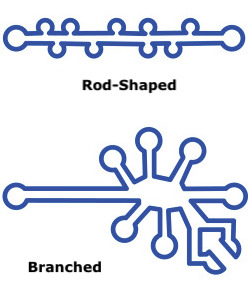
Viroid RNA typically comes in one of two forms -- rod-shaped and branched. All viroids start out as a circular piece of RNA when they are produced during replication, but the RNA then takes on a more complex shape. All viroids of a certain type have the same shape because the nucleotide sequence determines the secondary structure. Just like animals, plants suffer symptoms of disease when infected with viruses, such as reduced growth, changes in color, and death.
How does a piece of RNA do so much damage to a plant? Scientists think that viroids work by interfering with a plant’s ability to make normal RNAs. DNA is the molecule that makes up plant and animal genomes, and RNA primarily works to help build the proteins encoded by DNA. Messenger RNA, or mRNA for short, transmits the protein-building instructions from DNA, ribosomal RNA is an essential component of the protein-making ribosomes, and transfer RNA brings amino acids to make new proteins.
RNA also has many regulatory functions in cells. These other roles involve controlling what proteins get made and keeping protein products balanced in a cell. The regulatory RNAs tend to be less than 100 nucleotides long, which is very small even for an RNA, and many bind to messenger RNA to prevent it from making proteins.
| RNA Type | Abbreviation | Length (base pairs) | Function |
|---|---|---|---|
| Small interfering | siRNA | 20-25 | Silence mRNA by binding to it through complementary base pairing. |
| Micro | miRNA | 20-25 | Gene regulation |
| Piwi-interacting | piRNA | 20-35 | Involved in fertility, found primarily in the reproductive organs. |
| Long noncoding | lcRNA | >200 | Gene regulation, X-inactivation |
RNAs have even more functions than DNA -- they can even act as enzymes. Enzymes are protein molecules that facilitate chemical reactions. RNAs that have enzymatic activity are called ribozymes (ribonucleic acid + enzyme). In biochemistry, the structure of a molecule strongly influences its function, so ribozymes tend to have complex 3D structures that determine their function.
Viroid Pathogenesis
Because of the many regulatory activities of RNA, a single piece of RNA can cause a lot of changes in a cell. Based on studies of plant viroids, scientists have concluded that RNA silencing is the likeliest explanation for viroid pathogenesis. RNAs are silenced when they can not perform their normal functions, typically protein-encoding. Single-stranded RNA is silenced when a complementary sequence binds to it. This causes a cellular protein to degrade the now double-stranded RNA. miRNA and siRNA are both involved in RNA silencing.
Viroids harm host cells by interfering in the proteins that the cells make. Viroids enter the nuclei or chloroplasts (the photosynthesis-performing organelles in plants) and are replicated by plant enzymes. This may also divert the cell’s resources away from functions for its own survival. The ribozyme component of viroids helps cleave the replicated RNA to make a fully formed viroid.
Plants also use RNA silencing as a defense against viroids and RNA viruses. Studies have found RNAs that bind to viroids in infected plant cells, suggesting that they produce RNAs to mark viroids for degradation. This isn’t always successful, and we don’t know if plants have immune memory this way. Plants don’t have adaptive immunity with lymphocytes and antibodies, but they probably have some type of innate immune memory to help them “remember” pathogens.
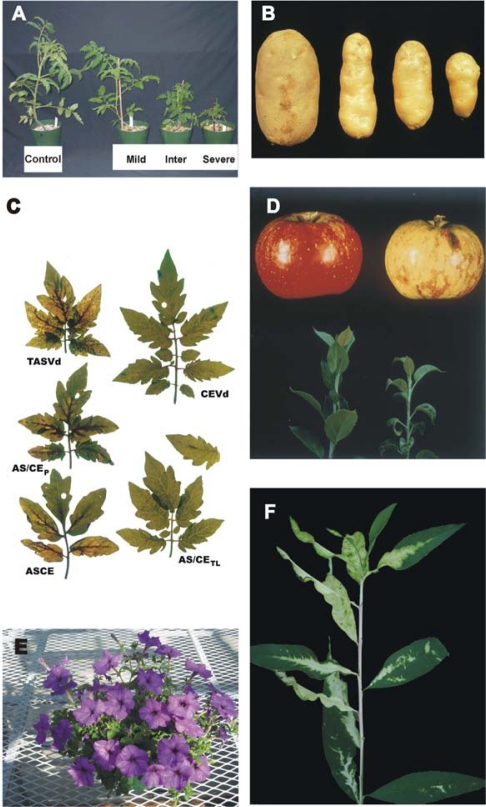
Source: Owens and Hammond, 2009. The figure on the left is from a report by scientists at the U.S. Department of Agriculture. It shows some of the common symptoms of viroid infection in plants, including stunted growth, yellowing or curling leaves, and discolored fruits. Different strains of viroid can cause varying severity of symptoms, as in the potato spindle tuber viroid infection in panel A. Some infections may not cause noticeable physical symptoms, such as in the Petunia plant in panel E.
Viroid RNA is processed to make small interfering RNAs. Fragments of viroid RNA silence genes similar to the mechanism by which siRNAs and miRNAs silence them in normal gene regulation 1. A famous example is the peach latent mosaic viroid, which produces small interfering RNAs that silence chloroplast heat shock protein 90. Scientists therefore predict that other viroids work similarly by interfering in plant gene regulation.
Viroid Transmission
Plants are the only organisms that are naturally infected by viroids. This is because free-floating RNA can only move between cells of plants because the cells are connected by certain types of channels called plasmodesmata.
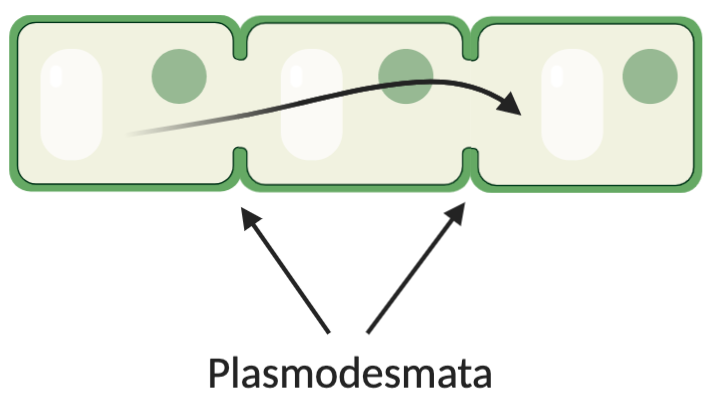
Free-floating RNA is easily degraded, so viroids do not travel easily between animal cells. The plasmodesmata of plant cells allow molecules to move between plant cells without technically being outside the cells. The specific shape of the 3D viroid RNA helps it move through the plasmodesmata within plants. Viroids can also travel to pollen and ovules in the reproductive organs of plants and be transmitted during pollination and seed germination.
Although they don’t naturally infect other organisms, viroids can cause disease in other cell types in the lab. One study showed that some types of viroid can be inserted into fungal cells, where the viroid reduced the growth and virulence of the fungus 2. The fungi normally cause disease in plants, so the scientists speculated that this viroid could cross from plants to fungi when a fungus is infecting the plant, potentially acting as a plant defense system.
Satellite Viruses
The largest of the three agents I will discuss are satellite viruses. These are viruses in the regular sense, but they are dependent on other viruses for replication, so they can’t infect host cells by themselves. Satellites can have DNA or RNA genomes, and they require a helper virus to package them and make new viral particles. Satellite viruses often inhibit the replication of the helper virus, but the genomes of satellites are distinct and not derived from the helper viruses Viruses are parasites of cells, and I think of satellites as parasites of other viruses.
Most satellite viruses are found in plants. The only human satellite virus is the hepatitis delta virus (HDV), which is a satellite of the hepatitis B virus (HBV). The surface proteins of hepatitis delta virus are encoded for and made by the hepatitis B virus. HDV encodes a long and short form of the delta antigen, which is found with the genome in virus particles.
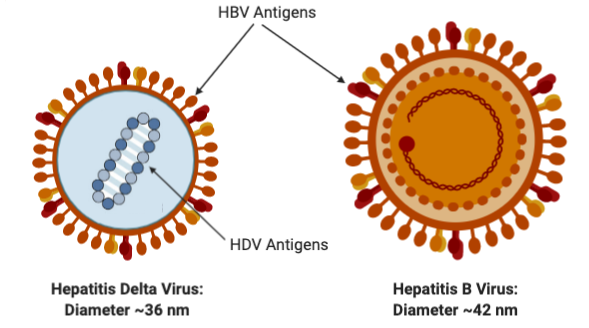
The delta antigen that hepatitis delta virus encodes for stabilizes its genome, is required for replication, and interferes with host proteins. But without hepatitis B virus, hepatitis delta virus can not enter and infect new cells or make new virus particles. In the laboratory, the hepatitis delta virus genome alone can be forced into cells using laboratory techniques.
Hepatitis delta virus shares many characteristics of viroids, but unlike them, it encodes proteins. It is actually a single protein with a long form and a short form. Its replication mechanism and the organization of its genome are like those of viroids. This could mean that the virus formed when a viroid passed through a person infected with hepatitis B virus, bringing together hepatitis B proteins and a viroid genome.
Approximately 350 million people worldwide live with chronic hepatitis B infection, and ~5% of these carriers are also infected with hepatitis delta virus 3,4. Infection with both viruses is more severe than infection with just hepatitis B. The good news is that the highly effective hepatitis B vaccine protects against infection by both viruses. The bad news is that our understanding of hepatitis delta virus is very limited, and we don’t have good diagnostic tests to screen for people with both viruses, who will need treatment earlier.
Another group of viruses similar to satellites are virophages that infect the giant mimivirus. In a previous post, I discussed how mimiviruses, which infect amoeba, are not completely virus-like because they have very large genomes and encode some proteins necessary for protein production. Other viruses can infect them, and there is some debate over whether these virophages are actually satellites. This virophage of the mimivirus was actually named Sputnik after the Russian word for “satellite.” Sputnik can only infect amoeba if the mimivirus is also present, but its exact classification is the subject of much debate 5.
Prions
Prions are probably the least understood of the unusual infectious agents. They are misfolded proteins that induce other proteins to misfold as well, leading to exponential spread inside an animal. Their name comes from what they are -- protein infections. This name was coined by American neurologist Stanley Prusiner, who won the Nobel prize in 1997 for their discovery.
The function of proteins is largely dependent on their structure, so misfolding can have dire consequences. Prion-related diseases share some similarities with Alzheimer’s and Parkinson’s diseases. Prions form abnormal aggregates called amyloid plaques, which impede normal tissue function and cause cell death 6,7. They cause neurodegeneration and are typically fatal. Prion diseases are very rare, causing approximately 1-2 cases per million people in the world 8,9. The incidence also increases with age. This is probably because this gives more time for prions to accumulate in tissues and cause damage.
Mad cow disease is a neurodegenerative disease of cattle. Cattle exhibit symptoms like weight loss, difficulty walking, and eventually impaired functioning, which leads to death. The sheep analog is called scrapie because infected sheep were observed scraping themselves on fences due to their altered mental state. If prions from animals spread to humans, they cause a disease called variant Creutzfeldt-Jakob disease.
Prion-related diseases in humans are categorized by how they are acquired. Infectious or acquired prions are spread between humans like any other infectious disease. The most well known example is the disease kuru in the Fore people of New Guinea. Consuming the brain tissue of other humans was found to be the cause. Since cannibalism stopped in the late 1950s, kuru has all but disappeared. Prions can also be spread in medical settings because they are stubbornly resistant to heat, UV light, common chemical disinfectants, and even many protein-degrading enzymes. Therefore, even sterilized medical equipment can transmit prions. But since the incidence of prions is so low, the likelihood of acquiring a prion disease this way is very low.
Familial human encephalopathies (brain-swelling diseases) are caused by a mutation that is passed down from parents to children. This mutation is in the prnp gene, which produces the prion protein. This protein is normally found in cell membranes, but the function isn’t fully understood. It is likely an ion channel or helps in the formation of synapses, connections between neurons that send signals to each other. Prnp is concentrated in the nervous system, but is also found at high levels in immune cells.
The normal form of Prnp is required for the pathogenic form to spread in an animal. In experiments, mice that lacked both copies of the prnp gene did not get infected by the scrapie form 10. These mice developed normally, so it seems that Prnp isn’t strictly necessary for animal survival. Below is a rough diagram of the structural differences between normal (cellular) and pathogenic (scrapie) prion protein. Proteins make structures called helices and sheets, and the relative amounts are very different between normal and disease-causing prion proteins. Misfolded proteins tend to have more sheets, which makes it easier for them to stick together.
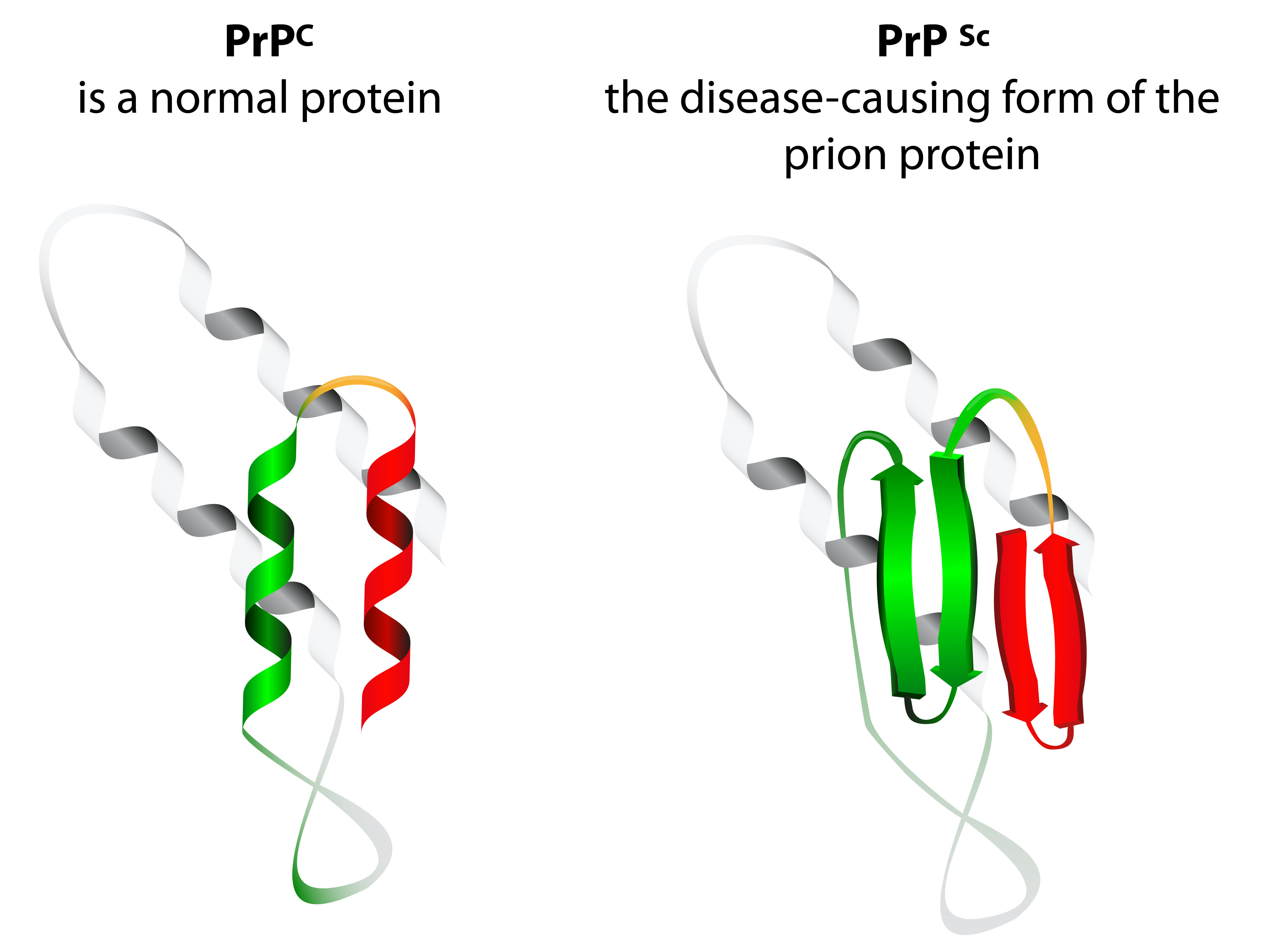
The third kind of prion disease is sporadic. This isn’t acquired through hereditary means, and it doesn’t come from other people. Cases of prion disease in humans who acquired it from infected animal tissue are classified as sporadic. Proteins can also spontaneously misfold, starting a new prion variant. Certain types of the prion protein are more likely to spontaneously misfold, and there are many different types in the population. These different versions cause variations in disease onset and severity, so we are still figuring out the development of disease.
The biggest questions about prions are how they arise and how they spread the misfolded shape to normally folded proteins. One theory is that prnp spontaneously misfolds, but the reaction is so slow that it rarely happens in most people. When a misfolded prion is acquired, it acts as a catalyst and speeds up the spontaneous reaction, which would explain both the necessity of prnp for disease to develop and the infectious nature of the prion.
Conclusion
Viroids, satellite viruses, and prions pose relatively little risk to the human population as a whole. Viroids can't infect animals, and prions are associated with few cases in the human population. Many prion diseases take years to develop, and people often die of other causes before the prion disease could become severe enough. Hepatitis delta virus is an exception because it probably infects millions of people, but we are simply unaware of the true scale. However, studying these other infectious agents gives us many insights into how life may have evolved and how biochemical reactions occur. They could also be implicated in chronic diseases with unknown causes.
Furthermore, many neurodegenerative diseases, like Alzheimer’s disease, Parkinson’s disease, Huntington’s disease, and amyotrophic lateral sclerosis (ALS) are caused by misfolded proteins building up in nervous system tissue and impeding normal functions. Although these diseases may not be directly due to prions, the progression of disease in both cases could be similar, and we may be able to learn how to better treat and prevent these diseases by studying prions.
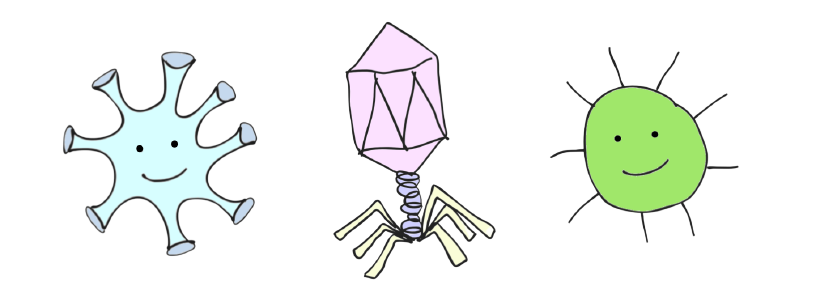
Leave a Comment